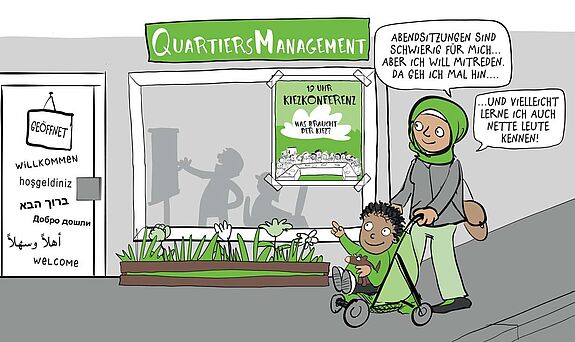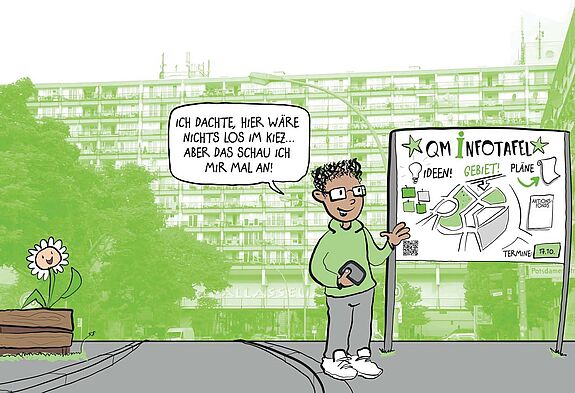Berliner Quartiersräte
Seit 2005 ist der Quartiersrat als Interessenvertretung der Menschen im Quartier ein verbindliches Modell der Bürgerbeteiligung im Berliner Quartiersmanagement. Ziel des Berliner Quartiersmanagements ist es, im Rahmen des bundesweiten Städtebauförderprogramms „Sozialer Zusammenhalt“ die Lebensbedingungen in benachteiligten Stadtquartieren zu verbessern. Der Quartiersrat trägt dazu bei, indem er über strukturfördernde sozio-integrative Projekte im Quartier mitentscheidet. Diese Projekte tragen beispielsweise zur Verbesserung der Bildungschancen, des nachbarschaftlichen Zusammenlebens, der Integration und der gesellschaftlichen Teilhabe bei.
Berlin’s Neighbourhood Councils
Since 2005, the neighbourhood council that represents the interests of the people in the district, has been a mandatory model of citizen participation in Berlin’s neighbourhood management. The goal of Berlin’s neighbourhood management is to improve the living conditions in the city’s disadvantaged neighbourhoods within the framework of “Social Cohesion”, a national urban development programme. The neighbourhood council contributes to this by having a say in the decision-making concerning socio-integrative projects that provide structural support in the neighbourhood. These projects help, for example, to improve educational opportunities, neighbourly coexistence, integration and social involvement.

1. Quartiersmanagement und Beteiligung
Neighbourhood management and participation
2. Ziel des Berliner Quartiersmanagements ist es, die Lebensbedingungen in benachteiligten Stadtquartieren zu verbessern. Das gelingt dann, wenn sich verschiedene Bevölkerungsgruppen im Quartier aktiv beteiligen können.
The goal of Berlin’s neighbourhood management is to improve the living conditions in the city’s disadvantaged neighbourhoods. This is successful if different population groups in the neighbourhood are able to participate actively.

3. Die Aktivierung und Beteiligung der Kiezbewohner und -bewohnerinnen geschieht durch vielfältige Formate (zum Beispiel Stadtteilkonferenzen oder Kiezspaziergänge). Es handelt sich hier ausschließlich um informelle Beteiligungsverfahren, die nicht in Gesetzen geregelt sind.
Activation and participation of the neighbourhood residents occurs in many formats (e.g. local conferences or walking tours of the neighbourhood). These are solely informal participation procedures, which are not regulated by laws.

4. Die Beteiligungsformate reichen von verschiedenen Aktionen der freiwilligen Betätigung und anderen niedrigschwelligen Angeboten für unterschiedliche Zielgruppen bis zum Engagement im Quartiersrat.
The participation formats range from various campaigns of voluntary activity and other low threshold offers for different target groups through to involvement in the neighbourhood council.
(Good idea, but does the neighbourhood really need it? … Let’s not make savings on the back of education … But this is the job of schools … Let’s vote … I don’t know enough about this, let’s invite somebody … This is good for the neighbourhood in the long-term)

5. Quartiersräte: Projektauswahl
Neighbourhood councils: project selection
6. Der Quartiersrat bietet unterschiedliche Möglichkeiten zur Mitentscheidung auf Quartiersebene. Sie reichen von der grundsätzlichen und langfristigen Planung der Quartiersentwicklung bis hin zur Auswahl von konkreten Projektideen und dem Einsatz finanzieller Mittel für Projekte.
The neighbourhood council offers different opportunities for having a say in decisions at neighbourhood level. They range from basic and long-term planning of the neighbourhood development through to the choice of specific project ideas and the use of financial resources for projects.

7. Die Projektideen, die von den Quartiersräten ausgewählt werden, folgen strategischen Schwerpunkten, die für die Entwicklung des Quartiers erarbeitet werden. Sie werden in einem Konzept, dem „Integrierten Handlungs- und Entwicklungskonzept“, verbindlich festgehalten.
The project ideas selected by the neighbourhood councils follow strategic priorities. These are worked up for the development of the neighbourhood and are recorded with binding effect in the “integrated action and development concept”.

8. Quartiersräte: Organisation und Wirkung
Neighbourhood councils: organisation and impact
9. Die Quartiersräte bestehen aus jeweils 15 bis 25 Personen. Mindestens 51 Prozent davon sind Bewohnerinnen und Bewohner. Die übrigen Mitglieder werden zum Beispiel von Vereinen, Schulen, Kitas, Religionsgemeinschaften oder Wohnungsunternehmen entsandt.
The neighbourhood councils are made up of 15 to 25 people. At least 51 % of them are residents. The remaining members are delegated, for example, by clubs and associations, schools, child daycare centres, religious groups or housing companies.

10. Die Mitglieder des Quartiersrats werden in der Regel alle zwei Jahre gewählt. Alle Bewohnerinnen und Bewohner im Quartier, die mindestens 16 Jahre alt sind, können wählen oder in den Quartiersrat gewählt werden.
The members of the neighbourhood council are usually elected every two years. All residents in the neighbourhood, who are at least 16 years old, can vote or be elected to the neighbourhood council.

11. Insgesamt setzte das Quartiersmanagement zwischen 1999 und 2019 7.255 Projekte um, die durch das Land Berlin, den Bund (Städtebauförderung) und die Europäische Union (EFRE) finanziert wurden. Ein Großteil dieser Projekte wurde von den Quartiersräten mitinitiiert oder begleitet.
Between 1999 and 2019, the neighbourhood management implemented a total of 7,255 projects, which were funded by the State of Berlin, the federal government (promotion of urban development) and the European Union (ERDF). Most of these projects were co-initiated or supported by the neighbourhood councils.